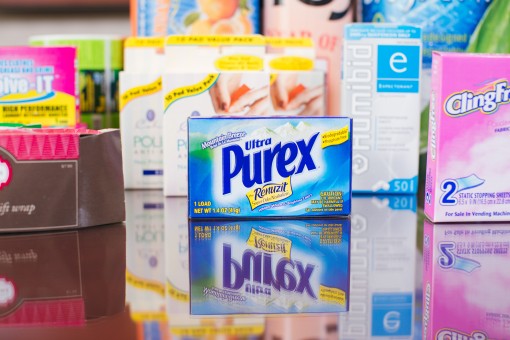Going Further with Flexo

Operator Chris Taylor and Kari Hudson, a floater, move a print head on one of Mimir Flexo Printing’s Mark Andy presses.
In a matter of a few hours, the staff at Mimir Flexo Printing can do something that would take most other package printers days, or even up to a week to accomplish.
Technically, the Troy, Missouri-based company operates four flexo presses, but if they wanted to, Director of Operations David Henke and his staff could create a new press every day. With a few quick rearrangements of print heads and diecutting and finishing stations, Mimir Flexo can completely customize each one of its presses.
What makes this possible is Mimir Flexo Printing’s access to equipment its competition doesn’t have. The company maintains four of the five Mark Andy Advanced Control Convertible Platform presses in the world. This press model, since taken off the market, was designed to be so customizable Henke likens it to a tinker toy or Erector Set.
“What makes these things hybrid and unique is the heads are all removable,” Henke explains. “We can put any head anywhere on any machine.”
All of the Above
While the trend in package printing is for companies to specialize in one specific area, Henke explains that the versatility of his equipment allows Mimir Flexo to have a hand in several applications in a variety of markets.
Though a substantial amount of Mimir’s work is in the folding carton field, the company’s presses also allow for film and label stock, creating an extensive range of substrate thickness Mimir can handle.
Henke explains that his equipment can print on everything from half-mil film to 24-point board, which increases the company’s versatility even further.
“Most plants are film plants, label plants or folding carton plants,” he says. “We’re all of the above. Plus, we do a lot of weird stuff with proprietary adhesives and laminations.”
By not being a specialist, Henke says Mimir Flexo is able to service several different markets. He explains the company prints for nutraceutical packaging, food and has recently seen substantial growth in the veterinary and pet food industry.
As SKU proliferation becomes an increasingly prevalent trend across several industries, Henke explains that pet food is an area that has been affected substantially. As this trend has developed, Henke says Mimir Flexo has been able to adapt along with it, handling shorter runs requiring fast changeovers, which are well-suited to his customizable equipment.
“These pet food companies are going into small breeds, large breeds—collie, Labrador,” he says. “They want us to run 500 of this bag, 7,000 of that bag. It just goes more into the SKUs and just-in-time delivery.”
All Flexo, All the Time
As Mimir Flexo Printing’s name suggests, the company solely operates flexographic equipment. Even as digital printing has worked its way into many package printing workflows, Henke says the company plans to remain steadfast in its flexo roots and has no desire to add digital equipment.
The No. 1 reason for this, Henke explains, is that Mimir Flexo is not set up for digital printing from a flow standpoint. But also, by focusing just on flexo, he is able to capitalize on running jobs that digital printers cannot, plus those that look better when printed flexographically.
“What most people are finding with digital is it’s a very narrow window of what it will print on,” Henke explains. “A lot of stuff that we do gets heat sealed and the heat affects digital inks. It doesn’t affect flexo inks. We actually do a lot of short-run stuff that used to be in the digital world because the ink and graphics look so much better flexo than they do digital.”
While there are advantages to flexo printing as compared to digital, Henke explains there are also areas where it shines over offset printing. Particularly in the folding carton market, Henke says a flexo production environment can provide significant cost savings to his customers over an offset workflow.
He states that in folding carton production, often the most expensive part of a job is acquiring dies. But being a flexo printer helps reduce costs because diecutting can occur in-line.
At Mimir Flexo Printing, customers are charged for press time, whether it is for printing or diecutting. Because diecutting in offset printing is often done offline, a customer at Mimir does not end up incurring an additional diecutting cost.
“In the offset world, you’re printing it on one machine and then coming back and diecutting on another machine,” Henke states. “Then, depending on whether or not it has stripping, you may be stripping it in a separate environment. Here, we’re putting a roll on one end and taking folding cartons off another end. They’re either ready to go into a box if they’re flat pack or ready to go to the folder gluer.”
No Sales Force, No Problem
Another quirk of Mimir Flexo’s strategy is that it does not intentionally seek out new business opportunities. Instead, the company relies on word of mouth and referrals in obtaining new jobs.
“We don’t have a sales force — zero, none, nada,” Henke says. “We only deal with brokers and manufacturers’ reps. Because of that, you can’t pull your 10 salesmen in a room and say, ‘OK this is what we’re good at. Go sell this.’ We have to take the opportunities that are brought to us.”
While taking this approach may seem inhibitive in such a competitive field, Henke says Mimir Flexo has no shortage of opportunities. In fact, he states that the company would not be able to handle every job that came its way.
“We don’t get every bid,” Henke says. “I would hope that we get 20 to 25 percent of what we bid. If you get it all, it means you’re too cheap. If you’re getting none of it, it means you’re too expensive. We couldn’t do it all, but you have to have some.”
Henke explains that word of mouth in the industry is helpful, but the company also relies on referrals. He explains that one of the company’s biggest strengths lies in its diecutting capabilities.
For example, if a potential customer approaches a die manufacturer like RotoMetrics with a job requiring an out of the ordinary diecut, Henke says that call is often redirected to Mimir Flexo.
“They’ll say ‘Call David out at Mimir. If he can’t do it, we don’t know who we’d send it to,’” Henke says.
Folding Carton Growth Through SKU Proliferation
It’s no secret in the retail and packaging industries that the number of SKUs provided by brands is growing exponentially. Henke points to the detergent market, where one brand may offer a product in liquid, powder, pod and granule form, with several different scents available for each.
This, he says, has been a boon for flexo printers because it took work away from gravure presses. Whereas in the past, a job would come in for 10 million of one box of a laundry detergent, now it’s more common to see an order for about 1 million boxes with multiple SKUs.
With flexo printing, Henke explains that in many cases with multiple SKUs, all it takes to switch from one product to another is a couple of quick plate changes. In Mimir Flexo’s case, many of the products it runs require multiple finishing elements, printing and diecutting in-line, which sets the company apart.
“Lots of times, it’s just a couple plates to change and you’re going from one carton to another,” he says. “In our instance where we’re laminating, barrier coating and barrier printing, therein lies the added value that no one else is doing.”
Under Promise and Over Deliver
As SKU proliferation has changed the packaging industry, Henke explains that the advent of just-in-time delivery has also changed how business is done. Because order quantities and the desired number of SKUs is constantly changing, Henke says it no longer makes much sense to store a large quantity of inventory at his facility.
“With the proliferation of SKUs came the proliferation of just-in-time delivery,” Henke says. “Another thing here is we hardly have any inventory. I would say 90 percent of our business is ‘make and ship ASAP.’”
Henke explains that Mimir Flexo also prides itself on having a very low percentage of waste—with less than 1 percent being returned from the customer. He says that documenting exactly what was done for each customer so the company can best replicate a job is essential, because at Mimir Flexo, the company expects that business to eventually return.
“We do a lot of repeat business,” Henke says. “It’s another testament to our success that we don’t lose customers. Our motto is under promise and over deliver. We do not lose customers.”

Cory Francer is an Analyst with NAPCO Research, where he leads the team’s coverage of the dynamic and growing packaging market. Cory also is the former editor-in-chief of Packaging Impressions and is still an active contributor to its print magazines, blogs, and events. With a decade of experience as a professional journalist and editor, Cory brings an eye for storytelling to his packaging research, providing compelling insight into the industry's most pressing business issues. He is an active participant in many of the industry's associations and has played an essential role in the development of the annual Digital Packaging Summit. Cory can be reached at cfrancer@napco.com














